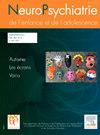非语言功能障碍(NDSD):对在Resodys专家中心接受治疗的89名患者进行知识更新和分析
Q4 Medicine
Neuropsychiatrie de l''Enfance et de l''Adolescence
Pub Date : 2025-09-01
DOI:10.1016/j.neurenf.2025.06.002
引用次数: 0
摘要
所谓的非语言学习障碍(NVLD)综合征是一种学习障碍,在临床、教育和社区环境中经常被讨论,特别是在盎格鲁-撒克逊国家和魁北克。然而,其病源特征仍然不明确,这阻碍了受影响儿童和青少年的早期识别,从而延误了诊断和适当干预方案的实施。在法国,这个词逐渐得到了研究学习障碍的专业人士的认可,而它对日常、学术和社会生活的具体影响也越来越得到认可。本文有三个主要目标:1/通过对近期出版物的简要文献回顾,包括两项荟萃分析和对少数神经影像学研究的总结,概述有关该疾病的表现和机制的当前知识;2/通过分析最近在法国PACA区域专门治疗严重学习障碍的r本文章由计算机程序翻译,如有差异,请以英文原文为准。
Le syndrome de dysfonctions non verbales (SDNV) : actualisation des connaissances et analyse d’une cohorte de 89 patients traités dans le centre expert Resodys
The so-called Non-Verbal Learning Disabilities (NVLD) syndrome is a type of learning disorder that is frequently discussed in clinical, educational, and community contexts, particularly in Anglo-Saxon countries and Quebec. However, its nosographic identity remains undefined, which hinders the early identification of affected children and adolescents and consequently delays diagnosis and the implementation of appropriate intervention protocols. In France, the term is gradually gaining recognition among professionals involved in learning disorders, while its specific impacts on daily, academic, and social life are also becoming more acknowledged. This article has three main objectives: 1/to provide an overview of current knowledge regarding the presentation and mechanisms of the disorder through a brief literature review focused on recent publications, including two meta-analyses and a summary of the few neuroimaging studies dedicated to it; 2/to address ongoing questions regarding the clinical reality of the disorder and its classification among learning disabilities and, more broadly, neurodevelopmental disorders (NDDs) by analyzing a cohort of 89 patients recently admitted to the Résodys center which is specialized in the care of severe learning disorders in the PACA region of France; 3/finally, in light of these findings, to examine the relevance of a new set of diagnostic criteria for clinicians, adopting a dimensional rather than categorical approach to better support affected children and adolescents. We thus propose a new perspective on this syndrome—one that no longer focuses on deviation from the norm but rather on two key observations: the multiplicity of moderately or partially affected cognitive domains, and the intra-individual performance discrepancies among these domains, particularly verbal and nonverbal. From this standpoint, our clinical experience diverges from a portion of the recent literature that equates NVLD with visuospatial disorder. More than an isolated cognitive deficit, the hallmark of this syndrome seems to lie in the coexistence of subtle impairments across several domains—even at a subclinical level. Though still limited, neuroimaging data tend to support the hypothesis of impaired connectivity among neural networks that jointly contribute to several of the cognitive functions involved.
求助全文
通过发布文献求助,成功后即可免费获取论文全文。
去求助
来源期刊

Neuropsychiatrie de l''Enfance et de l''Adolescence
Medicine-Pediatrics, Perinatology and Child Health
CiteScore
0.60
自引率
0.00%
发文量
61
期刊介绍:
Organ of the Société française de psychiatrie de enfant et de adolescent, Neuropsychiatrie de enfance et de adolescence tackles all fields of child-adolescent psychiatry and offers a link between field and clinical work. As a reference and training tool for students and practitioners, the journal publishes original papers in child psychiatry as well as book reviews and conference reports. Each issue also offers a calendar of the main events dealing with the speciality.
 求助内容:
求助内容: 应助结果提醒方式:
应助结果提醒方式:


